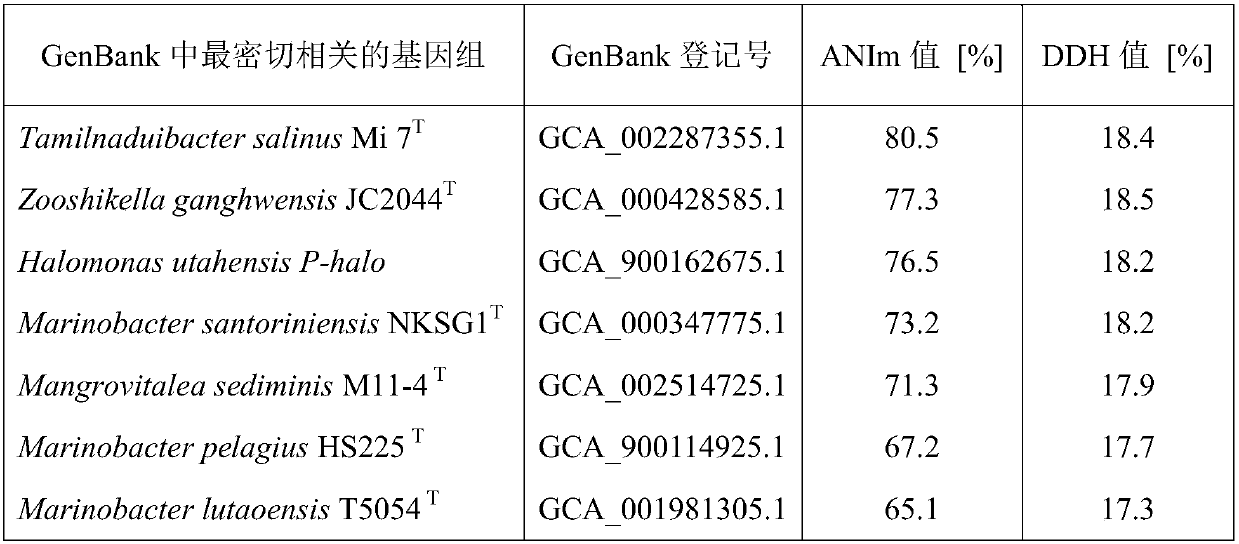Process for treating high-salt wastewater biological film through halophilic bacteria YL5-2
A treatment process, high-salt wastewater technology, applied in biological water/sewage treatment, water/sludge/sewage treatment, water pollutants, etc., can solve the problem of not providing halophilic bacteria or salt-tolerant bacteria species
- Summary
- Abstract
- Description
- Claims
- Application Information
AI Technical Summary
Problems solved by technology
Method used
Image
Examples
Embodiment 1
[0037] The isolation and preservation of the halophilic bacteria YL5-2 of embodiment 1
[0038] The halophilic bacteria YL5-2YL5-2 was isolated from the sedimentary soil of Golmucharhan Salt Lake (36°51′N, 94°95′E) in Qinghai Province, China. The water of Chaerhan Salt Lake is saturated or close to saturated salt concentration all year round.
[0039] Prepare LB liquid medium with a NaCl concentration of 20%, add 250 mg / L glycerol, 250 mg / L glucose, and 50 mg / L methanol, and enrich and cultivate the sedimentary soil of Chaerhan Salt Lake at 30-35°C for 24-72 hours. The strains in the enriched culture medium were isolated by using YL solid medium. 1L medium contains the following components: glucose: 0.6g, trisodium citrate 0.5g, glycerol 2mL, yeast extract 0.8g, peptone 1.6g, dipotassium hydrogen phosphate 0.35g, potassium dihydrogen phosphate 0.1g, ammonium sulfate 0.25g, ammonium chloride 0.25g, MgSO 4 0.5g, CaCl 2 0.1g, NaCl 180g; trace element SL-4 10mL, pH 7.0-7.2; ...
Embodiment 2
[0041] Example 2 16S rRNA sequence analysis and whole gene sequence analysis of halophilic bacteria YL5-2
[0042] Strain YL5-2 genomic DNA was extracted using TaKaRa kit (TaKaRa MiniBEST Bacteria Genomic DNA Extraction 68Kit Ver.3.0).
[0043]16S rRNA amplification was performed using universal bacterial primers 27F (5-AGAGTTTGATCMTGGCTCA G-3) and 1492R (5-TACGGYTACCTTGTTACGACTT-3). PCR sequencing was entrusted to Shanghai Sangon Biotechnology Co., Ltd. The complete 16S rRNA sequence of strain YL5-2 is 1518bp, and the GenBank accession number is MF782425.
[0044] The whole genome of strain YL5-2 was sequenced using the IlluminaMiSeq 2000 high-throughput sequencing platform of Shanghai Passino Biotechnology Co., Ltd. The original sequencing data was filtered and corrected using PRINSEQ (version number v 0.20.4) software, and then SOAP denovo software (version number v1.05) software with default parameters was used for genome base pairing, and then CheckM software (version n...
Embodiment 3
[0049] Example 3 Phenotypic characteristics and physiological and biochemical characteristics identification of halophilic bacteria YL5-2
[0050] Gram staining properties were tested using the BD Gram staining kit.
[0051] Cell motility was determined using half MA medium (0.5% agar, w / v).
[0052] Cell morphology was detected by transmission electron microscopy (TEM) analysis. That is, cells were picked from exponentially growing culture medium, stained with 0.5% uranyl acetate, and photographed under a microscope (Tecnai Spirit, FEI, Hillsboro, OR, USA).
[0053] Oxidase activity using the oxidase kit (bioMérieux), by adding 3.0% H 2 o 2 Catalase activity was determined by pouring the solution onto bacterial colonies and observing the generation of bubbles.
[0054] The temperature growth conditions were carried out on YL liquid agar medium, the temperatures were 4, 10, 15, 20, 25, 30, 33, 37, 40, 45 and 50 ° C, and the pH was constant at 7.5, and the strain YL5- 2 T...
PUM
| Property | Measurement | Unit |
|---|---|---|
| diameter | aaaaa | aaaaa |
| diameter | aaaaa | aaaaa |
| diameter | aaaaa | aaaaa |
Abstract
Description
Claims
Application Information
 Login to View More
Login to View More - R&D
- Intellectual Property
- Life Sciences
- Materials
- Tech Scout
- Unparalleled Data Quality
- Higher Quality Content
- 60% Fewer Hallucinations
Browse by: Latest US Patents, China's latest patents, Technical Efficacy Thesaurus, Application Domain, Technology Topic, Popular Technical Reports.
© 2025 PatSnap. All rights reserved.Legal|Privacy policy|Modern Slavery Act Transparency Statement|Sitemap|About US| Contact US: help@patsnap.com



